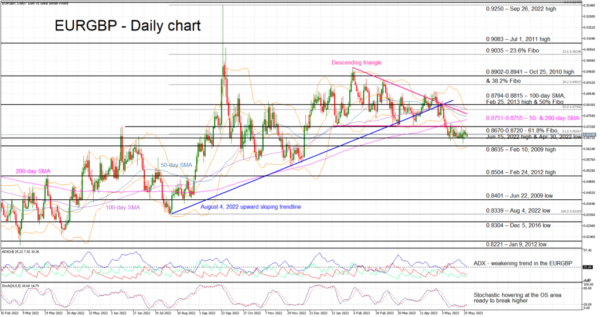Another week has just started, and it is another test for the ECB’s commitment to deliver price stability. With growth slowing down considerably, as seen at last week’s weaker business surveys, the focus turns to inflation figures. Could a mixed set of data create second thoughts at the ECB and put a (temporary?) stop to the recent euro/US dollar decline?
Where are we now?
With the US flirting with a debt default and a likely loss of its AAA rating, the euro area is experiencing a weaker growth patch. This was not widely expected considering the lower downside risks, especially as energy costs have been aggressively declining over the past few months. The much-expected Chinese reopening continues to disappoint, having a ripple effect across the globe and particularly affecting the German manufacturing powerhouse.
Does that mean that the ECB will pause in June? Based on the recent comments from president Lagarde and various members of the governing council, the ECB remains committed to its inflation target. Understandably, the hawks will maintain their hawkish commentary since the inflation rate remained elevated and negotiated wages have reached record high levels, increasing the chances of the much-dreaded second-round effects.
However, the doves are expected to make more frequent appearances, using last week’s growth data to justify their inflation-easing expectations for the second quarter of 2023. Similar to BoE’s strategy, the doves believe that weaker economic data could help them stop the imminent rate hikes.
May’s CPI will be the key release of the week
Amidst this environment, this week we have the release of the May CPI figures. The preliminary numbers from Germany and France are expected on Wednesday with the euro area aggregate scheduled to be released a day later. The national CPIs are seen edging lower to 6.5 % and 6.8% year-on-year (YoY) change respectively, still at extremely elevated levels. It is worth noting that French CPI remains just a tad below the recent high of 7.3% and it has not recorded yet the easing seen in other euro area countries’ figures.
Having said that, professional forecasters have penciled in a sizeable drop in the euro area aggregate from the 7% YoY change in April to 6.3% in May. If this is confirmed, it will be the lowest print since March 2022; a sign that the ECB’s restrictive monetary policy is working.
Should the actual figures deviate from market expectations, there is an asymmetric risk in terms of the possible surprises. An upside surprise will not materially affect market expectations for the next ECB meeting unless the figure climbs considerably above April’s 7% print. On the other hand, a much weaker outcome would clearly raise questions about the three extra rate hikes that the market is currently pricing in, a view also shared by most investment banks. This probable outcome could also remove a strong tailwind for the euro over the past few months.
Extra focus on German data
With the first quarter of 2023 remaining in negative territory of -0.3% GDP change on a quarterly basis, and the various business surveys portraying a rather weak environment for firms, the market will pay extra attention to incoming German data. With unemployment remaining at a record low level, Thursday’s retail sales would be an interesting read. Despite the higher wage increases, the retail sector remains under pressure. The annual rate of change remains in deeply negative territory, flirting with a double-digit drop. The recent reduction in energy prices could provide some breathing space, but potentially not enough to cause a significant improvement.
Euro range-trading against the pound
Contrary to the continued underperformance against the US dollar and despite last week’s upside surprise at UK’s inflation, euro bulls have managed to keep the euro/pound pair in a tight range. A downward breakout from the formed descending triangle has also taken place, but it appears to lack the strength for a more sustained correction.
At this juncture, a positive set of data this week would allow the euro bulls to recapture the 0.8720 level and target the busier 0.8751-0.8766 area that is defined by the 50- and 200-day simple moving averages (SMAs). On the other hand, a much weaker inflation print will finally help the euro bears overcome the key 0.6870 and 0.6835 levels respectively, opening the door for a stronger move towards the 0.8500 area.














